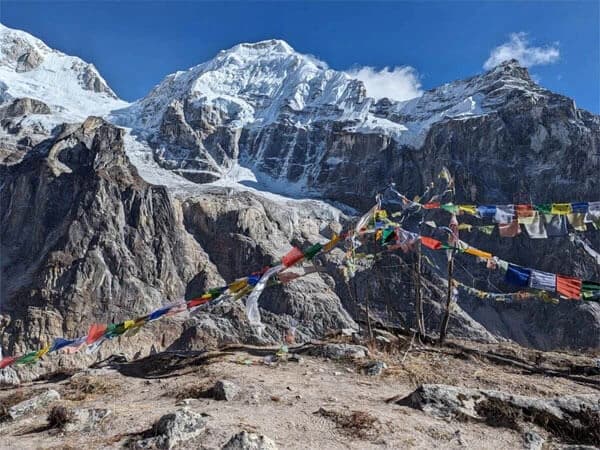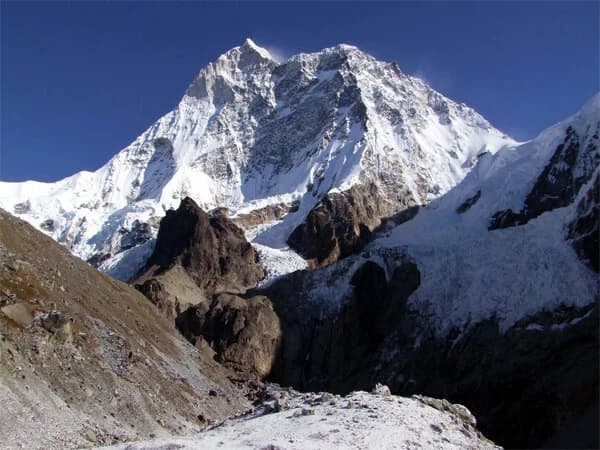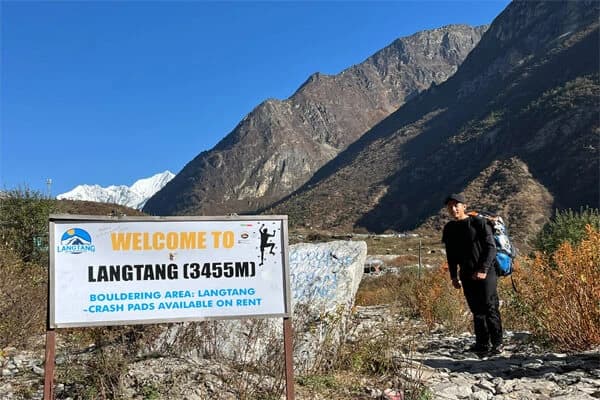Every traveler should consider theMakalu Base Camp trek difficulty before going on this adventure. This journey is often described as difficult due to the fact that it passes through isolated and wild areas in eastern Nepal. Because the Makalu region is less developed than well-known routes like the Annapurna Circuit or Everest Base Camp, there are less lodges, amenities, and comforts along the route. The paths are rocky, steep, and occasionally slippery, particularly when going across high mountain passes. High altitude and long walking days make it harder more difficult, so mental and physical toughness are crucial.
The altitude itself is a major challenge because the trek goes above 5,000 meters. This increases the risk of altitude sickness, so proper acclimatization is a must. The weather can also be unpredictable, with cold nights and sudden changes in conditions. Trekkers need to carry proper gear, including warm clothes and sturdy boots, to stay safe.
Despite the difficulties, the Makalu Base Camp trek is also one of the most rewarding journeys in Nepal. The remote trails, untouched nature, and breathtaking views make the effort worthwhile. In this blog, we will look deeper into what makes this trek difficult and how to prepare for it.
Makalu Base Camp Trek Difficulty Level
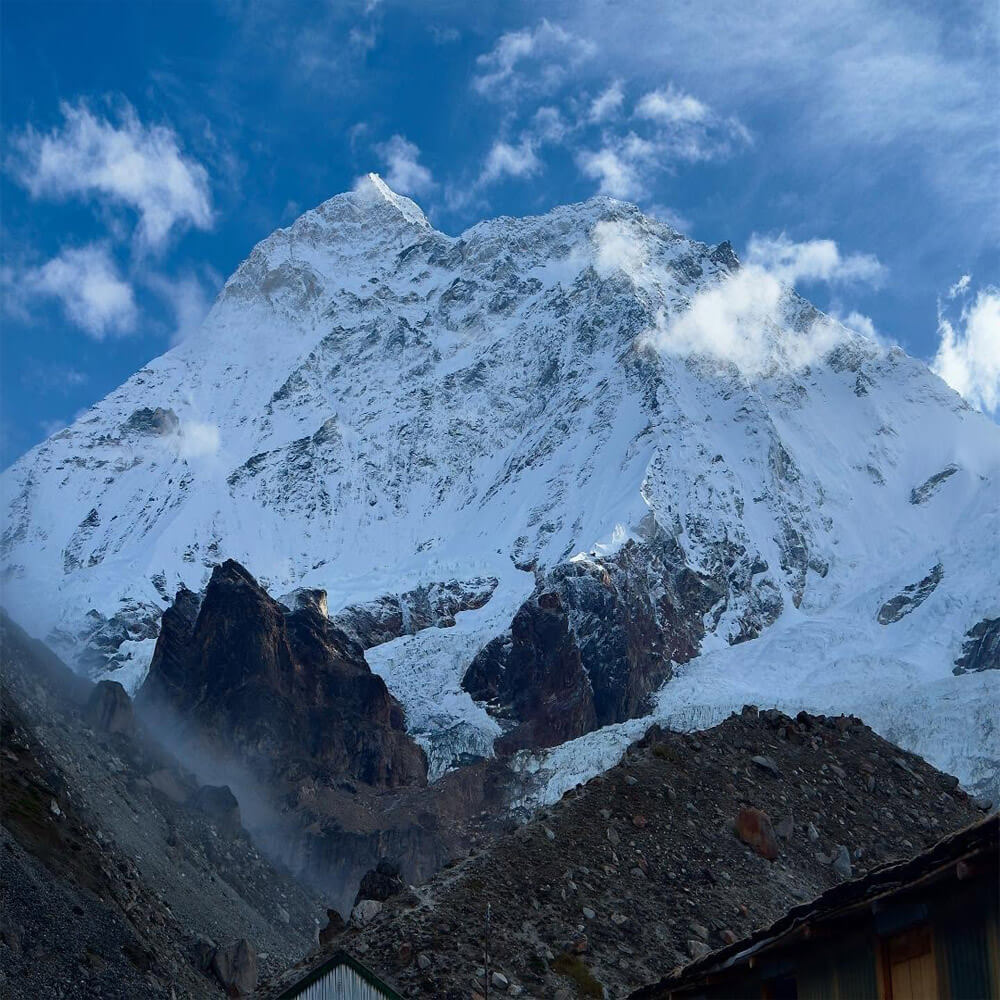
It is important to realize that the Makalu Base Camp Trek is among the most difficult treks in Nepal when discussing its general level of difficulty. Because the Makalu trail is less developed than well-known routes like Everest Base Camp or the Annapurna Circuit, it has more rugged terrain, fewer teahouses, and fewer tourists. The trails are frequently rough, steep, and occasionally slippery, particularly in the rainy season. Trekkers must be ready for lengthy walking days, which typically last six to eight hours. Shipton La Pass, which is nearly 5,000 meters above sea level, is another high point on the climb that increases the danger of altitude sickness if you do not adequately acclimate.
The area's isolation is another element that adds difficulty to the walk. There are less amenities including lodging, dining options, and medical care because it is less commercialized. On more well-traveled trekking routes, you can not count on the same degree of comfort. Because trekkers need to be physically fit and have a strong mentality, the isolation makes things more challenging. Nevertheless, the difficulty is worth it because of the Makalu region's unspoiled vistas, thick woods, and up-close views of Mount Makalu.
Making the connection between budgeting and the trek's difficulty is also helpful. The Makalu base camp trek cost is a question that many trekkers have, and it is important to keep in mind that cost might vary depending on difficulty. For instance, meals and lodging are typically more expensive in this isolated area than in more popular trekking destinations. To make your trip safer and more seamless, you might also need to employ knowledgeable porters or guides, which raises the price. Additionally, because this expedition is longer (about 20–22 days), you will need to pay more for permits, equipment, and daily expenses.
In conclusion, the trek to Makalu Base Camp is logistically difficult, mentally challenging, and physically demanding. However, the benefits are amazing if you are financially and physically prepared. The once-in-a-lifetime experience and the unadulterated Himalayan landscape make the more expensive Makalu base camp trek worthwhile.
Makalu Base Camp trail conditions
One thing is clear while discussing the Makalu Base Camp adventure: it is truly a remote and off-the-beaten-path trek Nepal offers. This trail leads you into unexplored valleys, sleepy towns, and untamed landscapes that are rarely visited by trekkers, in contrast to the more popular Everest or Annapurna routes. Although it adds to its allure, it also makes the trail and terrain more difficult.
Steep Climbs and Descents
There are many lengthy climbs and descents on the trail. There will be days when you spend hours going uphill on stone steps, just to descend steep wooded paths the following day. It may be exhausting to experience this continuous elevation shift, particularly if you are not accustomed to long treks. Trekkers have a sense of accomplishment and adventure despite the challenging terrain.
Narrow and Rocky Paths
The routes are difficult, rocky, and tight in several spots. There are parts when you cross suspension bridges across rushing rivers or stroll along the sides of cliffs. The walk is fascinating because of these conditions, but it also calls for extra prudence. Walking poles and appropriate trekking shoes can significantly improve balance and lessen knee discomfort.
Remote Trails with Fewer Facilities
The trail lacks as many teahouses and contemporary amenities as the more well-known trekking areas since it is a remote and off-the-beaten-path trek Nepal showcases. You may walk for hours at a time before you find a place to stop and rest. To stay comfortable on the walk, trekkers must therefore pack a few necessities, such as snacks, water purification tablets, and additional warm clothes.
Changing Natural Landscapes
The speed at which the terrain changes is among its most remarkable features. Before arriving at high alpine regions with snow-capped peaks, you first traverse rice terraces and subtropical forests before entering rhododendron woodlands. Although these frequent changes maintain the trek's breathtaking scenery, they also bring with them changing trail conditions, such as cold, rocky pathways or muddy jungle paths.
Makalu Base Camp's terrain and trail conditions provide for a demanding yet worthwhile experience. This type of trek captures the essence of the remote and off-the-beaten-path trek Nepal is known for, making it ideal for individuals seeking an pure, genuine mountain experience.
Makalu trek altitude challenges
High Altitude Trekking in Nepal and Its Demands
A prime example of the high altitude trekking in Nepal is renowned is the Makalu region. This climb necessitates more mental and physical preparation than lower level treks like Langtang Valley or Ghorepani Poon Hill. By the time you arrive at Makalu Base Camp, the thin air puts your endurance to the test. Trekking over 3,500 meters is already difficult. In high-altitude terrain, it becomes imperative to stay hydrated, walk gently, and pay attention to your body.
Why Acclimatization Matters in Makalu Base Camp Trek
The process of acclimatization in Makalu Base Camp trek is one of the most crucial components of successfully finishing the journey. You travel over 5,000 meters on this trip, where the oxygen content drastically decreases. Trekkers run the risk of developing altitude sickness, which can result in headaches, nausea, dizziness, or worse, compel them to stop their journey, if they do not get enough sleep and ascend gradually. Most itineraries include rest days to prevent this, particularly in the vicinity of Khongma Danda and Mumbuk, so that the body can acclimate before ascending further.
Tips for Safe Acclimatization
- Follow the climb high, sleep low principle: Climb higher throughout the day if the trail permits, then return to sleep at a somewhat lower elevation.
- Add extra days if possible: You have breathing room to rest if symptoms arise thanks to flexible itineraries.
- Eat light, nutritious meals: At altitude, heavy meals can slow down digestion, yet local cuisine and soups provide you energy.
- Avoid alcohol and smoking: These two behaviors hinder the absorption of oxygen, which makes acclimation more difficult.
The Reward of Proper Acclimatization
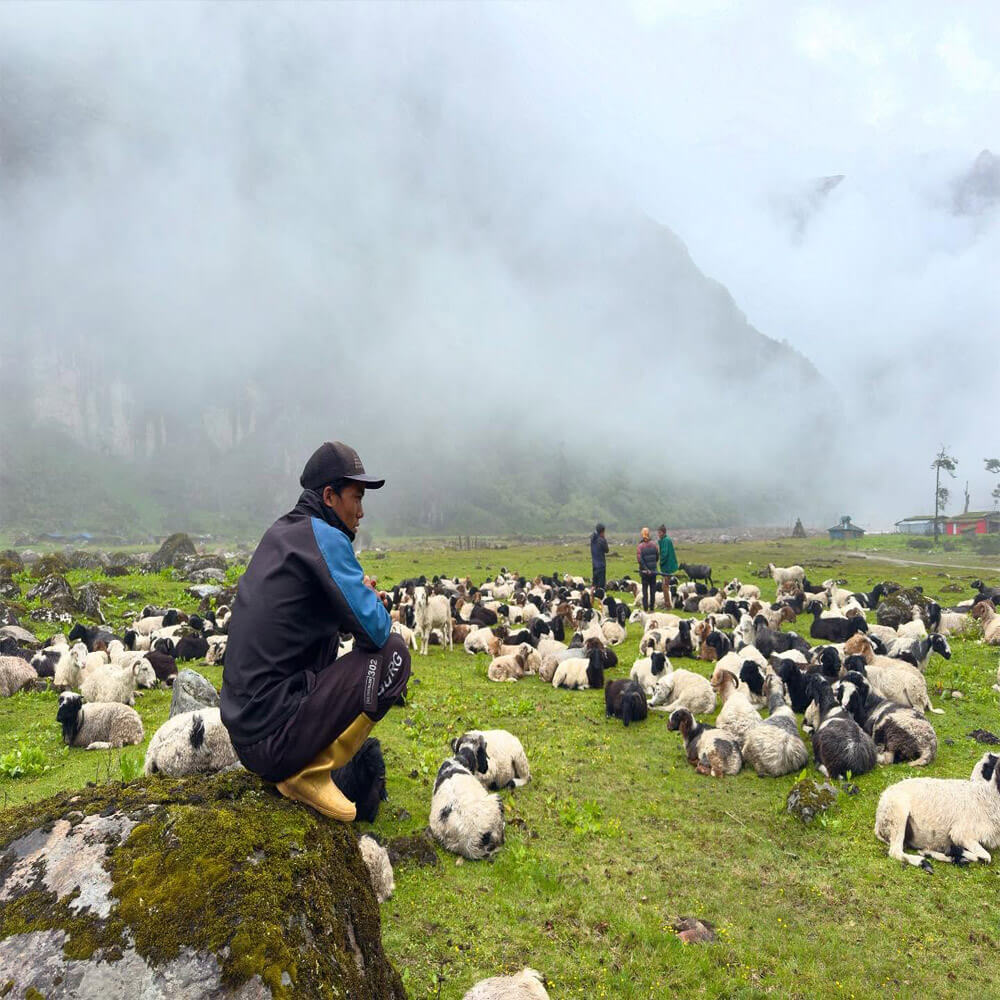
Despite the frightening altitude, the climb is safe and incredibly rewarding because to careful planning. Many trekkers claim that the slow rate of acclimatization keeps them healthy and enables them to take in the breathtaking Himalayan scenery to the fullest. The Makalu Base Camp trekking trip becomes a genuine adventure in the middle of Nepal's wildness if one has the correct attitude and respects altitude.
Length and duration of Makalu trek
One of the lengthier treks in Nepal is the Makalu Base Camp Trek, and its length greatly contributes to its perceived difficulty. Depending on the walking pace, acclimatization days, and itinerary selected, the journey typically takes 20 to 22 days to finish. The Makalu trekking trip is more difficult overall because it takes more time and effort than shorter treks like Ghorepani Poon Hill or Langtang Valley.
Long Walking Days During the Makalu Base Camp Trek
The majority of trekking days entail 6–8 hours of walking, frequently on rocky paths with difficult ascents and descents. Trekkers should prepare for more difficult conditions because the pathways are less constructed than more well-traveled routes like Everest or Annapurna. Both mental and physical endurance are required for the long days. This element raises the technical difficulty of Makalu trek since it can be more difficult to manage exhaustion over an extended period of time than it is for shorter, simpler treks.
Altitude and Acclimatization
At 4,870 meters, the trek reaches Makalu Base Camp, when elevation becomes a major obstacle. To prevent altitude sickness, the lengthy trip necessitates meticulous planning of acclimatization pauses. Over three weeks on the trail also puts a trekker's capacity to adjust to shifting weather patterns and thinner air to the test. The trek is technically challenging due to the gradual but constant ascent because safe pace is essential.
Remote and Isolated Trekking Route in Makalu Base Camp Trek
The Makalu area is rarely visited, which makes things more challenging. Trekkers frequently encounter basic lodgings, few resupply options, and minimal amenities. Because of its remoteness, each trekking stage lasts longer and necessitates bringing more items. This increases the technical difficulty of Makalu trek in comparison to commercial trekking locations because it requires more thorough planning and preparation.
To put it briefly, the length and duration of the Makalu trek encompass more than just mileage traveled. They put a trekker's stamina, capacity for altitude adaptation, and preparedness for harsh environments to the test. The trek is lengthy, daring, and technically challenging as a result of this mix.
Weather challenges in Makalu trek
Preparing for the Makalu Base Camp walk requires an understanding of the weather, particularly as the level of difficulty varies with the season. The best season to trek Makalu Base Camp difficulty-wise ensures safer trails, clear views, and a more comfortable experience.
Makalu Base Camp Trek in Spring Season (March–May)
Many people agree that spring is one of the greatest seasons to visit Makalu. At lower elevations, the routes are usually free of snow and the temperatures are temperate. Along the way, alpine flora such as blooming rhododendrons add splendor. In terms of difficulty, spring is simpler because of the consistent weather and longer days, which enable gradual trekking without hurrying. Acclimatization is necessary since higher elevations might still be frigid.
Makalu Base Camp Trek in Autumn Season (September–November)
Another great time of year to trek to Makalu Base Camp is in the fall. The sky are typically clear after the monsoon, providing breathtaking views of the Himalayan peaks, including Makalu and Lhotse. The approach and descent are safer because the trails are dry and less slippery. Because of the regular weather and low chance of landslides, trekking in the fall is less difficult than in the monsoon or winter.
Makalu Base Camp Trek in Winter Season (December–February)
Temperatures drop in the winter, particularly over 4,000 meters. The walk can become more challenging when snow and ice cause pathways to become slippery and challenging to follow. The route may be more tranquil because there are less trekkers, but there are also fewer tea houses and fewer facilities available. For people who are new to high-altitude trekking or are not experienced, winter is not the best season.
Makalu Base Camp Trek in Monsoon Season (June–August)
The monsoon season is the least advantageous. Poor visibility, landslides, and slippery routes can all result from heavy rain. Trekking becomes more hazardous and physically taxing due to high humidity and damp paths. From the standpoint of difficulty, the monsoon season is typically avoided and presents a major rise in problems.
The best season to trek Makalu Base Camp difficulty-wise is spring or autumn, when you may take advantage of the beautiful mountain views, safer paths, and more tolerable weather. Trekkers may concentrate on the route rather than enduring difficult conditions during these seasons since they offer the perfect balance between comfort and excitement.
Physical fitness for Makalu trek
Trekking to Makalu Base Camp safely and enjoyably, one must be in good physical condition. Preparation is essential because the trek entails lengthy walking days, steep ascents, high altitude, and rocky routes. Fitness training for Makalu Base Camp trek ensures that your body can handle the physical demands while minimizing the risk of fatigue or injury.
Cardiovascular Training
Cardiovascular workouts fortify your heart and lungs, enabling you to handle extended trekking days and low oxygen levels at high elevations. Running, cycling, stair climbing, and brisk walking are all great options. For a few weeks before to the walk, try to get in at least 30 to 45 minutes four or five days a week. By increasing stamina, this training helps your body adjust to endurance problems and makes uphill treks feel less taxing.
Strength Training
Strengthening your muscles is equally vital. For trekking, pay particular attention to the muscles engaged in the legs, core, and back. Exercises that prepare your body for long uphill climbs, lugging backpacks, and keeping balance on uneven slopes include squats, lunges, step-ups, and planks. Additionally, having strong muscles lowers the chance of joint pain and injury from long walking days.
Endurance and Trekking Practice
There is nothing that can replace actual trekking experience. To replicate trek conditions, walk on hills or uneven terrain while carrying a full backpack. To develop endurance, progressively increase elevation and distance. Your body adjusts to the monotonous strain of daily walking with the help of weekend treks in neighboring mountains or trails.
Flexibility and Recovery
To increase flexibility and avoid injuries, use Pilates, yoga, or stretching in your regimen. In order for muscles to heal and become stronger, recovery days in between training sessions are essential.
Proper fitness training for Makalu Base Camp trek not only enhances performance but also boosts confidence, making the trek more enjoyable. A prepared body is better able to withstand the altitude, steep terrain, and long walking hours, making the Himalayan trip safer and more unforgettable.
Tea Houses and Facilities on Makalu Base Camp Trek
The presence of tea houses and other basic amenities is a crucial factor for anyone organizing the Makalu Base Camp Trek. Due to the trek's isolated location in eastern Nepal, accommodations are more basic and scarcer than on more well-traveled routes like Everest or Annapurna. Trekkers can plan and enjoy their expedition more safely if they know what to expect.
Tea Houses and Lodging
The majority of the communities along the Makalu Base Camp route have modest tea houses that offer simple lodging. Usually shared, rooms have just blankets and beds. There are a few stops where private accommodations can be available. At higher elevations, electricity could only be available for a few hours per day, and hot showers are uncommon. Trekkers should be ready for primitive living, which enhances the experience but calls for adaptability and an optimistic outlook.
Food and Dining
Tea houses serve modest, regional dishes including tea, noodles, soups, and dal bhat (rice and lentils). Although there are not as many options as in cities, the cuisine is wholesome and satisfying, which helps trekkers stay energized on long days of walking. As part of the cultural experience, dining in tea houses allows visitors to get a taste of the hospitality and way of life in isolated Himalayan villages.
Accessibility and Supplies
The isolated nature of the area necessitates careful supply planning for trekking in Nepal along the Makalu trail. Certain goods, including as medicines, snacks, and personal hygiene items, ought to be transported from smaller towns like Tumlingtar or Num. There are little stores in the villages along the trail, but they are more expensive and harder to find.
Tips for Comfort
- For warmth, bring your own sleeping bag.
- Keep a tiny, portable power bank with you for your gadgets.
- Due to the possibility of crowding during the busiest time of year, tea shops may require patience and flexibility.
Tea houses provide a chance to interact with locals and make the walk more manageable despite their minimal amenities. For those trekking with our agency Nepal Trekking Routes, guidance ensures that accommodation and meals are arranged efficiently, allowing trekkers to focus on enjoying the stunning scenery and cultural experience.
Guide and Porter Support on Makalu Base Camp Trek
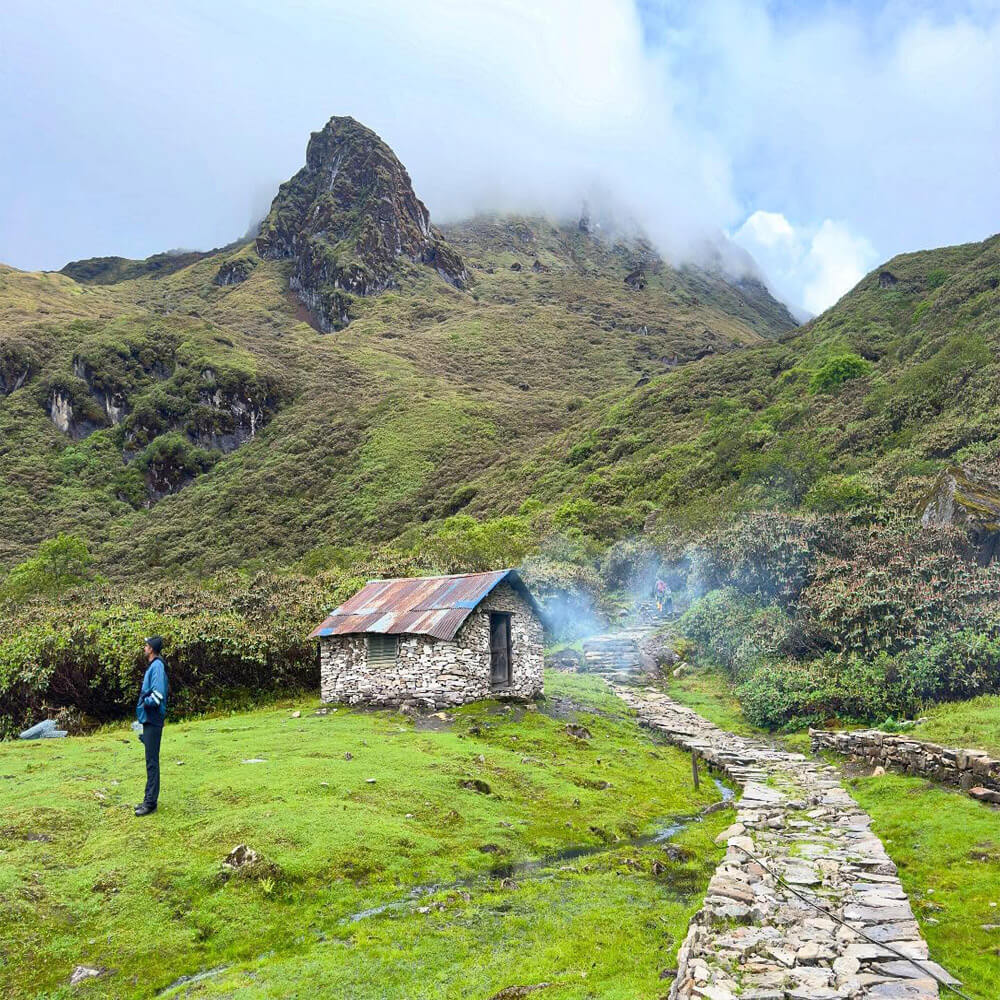
Having the appropriate support staff is crucial when organizing the Makalu Base Camp Trek. It can be physically taxing and difficult to trek in the Himalayas, particularly in isolated places like Makalu. Employing a qualified guide and porter guarantees comfort, safety, and a more pleasurable trip.
Role of a Trekking Guide During Makalu Base Camp Trek
Navigating the Makalu region requires the assistance of an experienced trekking guide. They have received training in trail reading, hazard identification, and altitude acclimatization. Additionally, guides assist with Makalu Base camp trekking itinerary management, making sure that you keep a safe pace and plan rest days as necessary. Guides also enhance the experience by imparting knowledge about the customs, culture, and nature of the area. A guide serves as a mentor, safety advisor, and storyteller for anyone trekking in Nepal in addition to being a navigator.
Benefits of Hiring a Porter
Porters help you trek comfortably and without exerting yourself by carrying your bulky bag, which is often between 15 and 20 kg. This is especially useful on Makalu's steep climbs and descents, where every ounce of energy matters. When you have a porter, you can concentrate on soaking in the stunning Himalayan landscape, snapping pictures, and acclimating to the altitude. Porters also assist with logistics management, such as transporting supplies to far-flung tea houses with inadequate amenities.
Safety and Peace of Mind
Trekking in isolated areas, such as Makalu, can be unpredictable due to unforeseen weather conditions or challenging trails. Having qualified experts at your side increases your level of security. They can handle crises, make travel arrangements if necessary, and guarantee that your journey stays safe and easy.
Choosing the Right Support
Using our company, Nepal Trekking Routes to plan your trek guarantees knowledgeable guides and reliable porters. We offer help during the trip, appropriate equipment, and local knowledge. Professional advice and porter assistance enable anyone planning a trekking in Nepal experience to make difficult treks like Makalu Base Camp not only feasible but genuinely unforgettable.
Makalu trek for beginners or experienced trekkers
Due to its difficult terrain, high elevation, and lengthy trekking days, the Makalu Base Camp Trek is typically not advised for beginners. The trails, which call for good balance, endurance, and trekking experience, have small paths, rocky sections, steep ascents and descents, and sporadic river crossings. Another important consideration is altitude; at 4,870 meters, the base camp is at a considerable danger of altitude sickness. For both safety and enjoyment, proper acclimatization and prior experience with moderate to high-altitude treks are essential.
Makalu provides seasoned trekkers a unique and fulfilling experience. It offers a more remote and unspoiled Himalayan experience because it is less busy than the Annapurna or Everest regions. Trekkers can take in stunning views of traditional Sherpa and Rai villages, as well as Makalu, Baruntse, and the surrounding peaks. The walk requires resilience, preparation, and high physical fitness because it blends cultural immersion with physical effort. Expert trekkers gain from the assistance of guides and porters, which simplifies logistics and navigation while preserving the excitement of a strenuous high-altitude journey.
Beginners may find the Makalu Base Camp Trek very difficult unless they are well-prepared, accompanied, and physically fit. This trek is best suited for trekkers with prior experience.
Conclusion: Makalu Base Camp Trek Difficulty
Many people consider the Makalu Base Camp Trek to be among the most difficult Himalayan treks in Nepal. Only well-prepared and physically fit trekkers should attempt it due to its rough terrain, steep ascents, and high-altitude paths. Walking for long periods of time each day requires acclimation to lower the risk of altitude sickness. The monsoon season's cold, snow, and sporadic landslides can make things more challenging. There are not many options for lodging or food, so preparation is key. Adventurers who successfully complete the trek are rewarded with stunning vistas of Makalu, the fifth-highest peak in the world, and pristine landscapes that are rarely visited by tourists.
It is strongly advised to select knowledgeable guides and support personnel because they guarantee trail safety, navigation, and cultural understanding. To make the journey easier to handle, our company, Nepal Trekking Routes offer a wide range of services, such as permits, logistics, and expert advice. With planning, perseverance, and encouragement, the trek to Makalu Base Camp turns into a once-in-a-lifetime Himalayan experience.
Frequently Asked Question
How hard is Makalu Base Camp Trek?
The Makalu Base Camp Trek is considered strenuous and challenging. The trails involve steep ascents and descents, uneven terrain, and high altitudes, reaching up to 4,870 meters. Trekkers need good stamina, balance, and prior trekking experience to complete it safely.
Can beginners attempt the Makalu Base Camp Trek?
This trek is generally not recommended for beginners due to its long daily walking hours and high-altitude risks. Beginners may find it physically demanding, but with proper preparation, fitness training, and a professional guide, it can be attempted cautiously.
How does altitude affect the difficulty?
Altitude is a major factor. The risk of altitude sickness increases above 3,500 meters. Proper acclimatization days are crucial to avoid headaches, nausea, or fatigue. Trekking slowly and drinking plenty of water helps manage altitude challenges.
What kind of fitness level is required?
A good level of physical fitness is necessary. Trekkers should practice cardio, leg strength, and endurance exercises before the journey. Previous experience on moderate to high-altitude treks is highly recommended.
How can the difficulty be managed?
Using experienced guides, hiring porters, pacing yourself, and choosing the right season can make the trek more manageable. Nepal Trekking Routes provide logistical support, local knowledge, and safety measures, reducing the physical and mental challenges of the Makalu Base Camp Trek.





